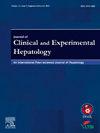Transjugular Intrahepatic Portosystemic Shunt Related Hepatic Encephalopathy in Cirrhotics With Refractory Ascites: Incidence and Correlation With TIPS Stent Diameter and Pre-TIPS Sarcopenia
IF 3.2
Q2 GASTROENTEROLOGY & HEPATOLOGY
Journal of Clinical and Experimental Hepatology
Pub Date : 2025-08-27
DOI:10.1016/j.jceh.2025.103125
引用次数: 0
Abstract
Objectives
Aims of this study were to compare the incidence of hepatic encephalopathy (HE) in 8 mm and 10 mm transjugular intrahepatic portosystemic shunt (TIPS) stent, the predictive factors for HE, and to assess the change in muscle quantity and quality after TIPS.
Methods
A retrospective cross-sectional study of patients who underwent elective TIPS placement between 2012 and 2022 was conducted. A total of 535 patients were assessed for eligibility, of which 253 patients were excluded and 282 were included for analysis. HE was defined based on predefined criteria and the incidence was calculated. Parameters in HE and non-HE groups were compared to identify predictive factors, and predictive models were developed.
Results
Complete or near-complete resolution of ascites was significantly higher (P-value 0.005) and stent block or dysfunction requiring reintervention was lower with 10 mm stent (P-value 0.005). However, the incidence of HE was higher in 10 mm (49/282, 63.6%) as compared to 8 mm group (28/282, 36.4%) (P-value 0.459; nonsignificant). Patients with post-TIPS HE had low skeletal muscle index (SMI), psoas muscle index (PMI), and psoas muscle attenuation (PMA) (P < 0.001) while intramuscular attenuation coefficient (IMAC) was high (P < 0.001). There was significant improvement in SMI, PMI, and PMA after TIPS, while IMAC and liver stiffness measurement (LSM) showed a significant decrease. PMI, PMA, history of prior HE, and Model For End-Stage Liver Disease (MELD) were identified as independent predictors for HE. A model was devised based on these parameters with a predictive value of 71.3 percent.
Conclusion
10 mm-TIPS stent was associated with better ascites control at the cost of an increased incidence of HE. Prediction for post-TIPS HE may be done using PMI, PMA, history of prior HE, and MELD. TIPS may lead to improvement in the status of muscle quantity and quality, thus reducing the probability of HE.

肝硬化合并难治性腹水的经颈静脉肝内门静脉系统分流相关肝性脑病:TIPS支架直径和TIPS前肌少症的发生率和相关性
目的比较8mm和10mm经颈静脉肝内门静脉分流术(TIPS)支架内肝性脑病(HE)的发生率、HE的预测因素,并评价TIPS后肌肉数量和质量的变化。方法对2012年至2022年间择期行TIPS置入术的患者进行回顾性横断面研究。共有535例患者被评估为合格,其中253例被排除,282例被纳入分析。根据预先定义的标准定义HE并计算发病率。比较HE组和非HE组的参数以确定预测因素,并建立预测模型。结果10 mm支架的腹水完全或接近完全溶解率显著高于10 mm支架(p值0.005),支架阻塞或功能障碍需要再干预的发生率显著低于10 mm支架(p值0.005)。但10 mm组HE发生率(49/282,63.6%)高于8 mm组(28/282,36.4%)(p值0.459,无统计学意义)。术后HE患者骨骼肌指数(SMI)、腰肌指数(PMI)和腰肌衰减(PMA)较低(P < 0.001),肌内衰减系数(IMAC)较高(P < 0.001)。TIPS后SMI、PMI和PMA有显著改善,而IMAC和肝硬度测量(LSM)有显著降低。PMI、PMA、既往HE病史和终末期肝病模型(MELD)被确定为HE的独立预测因子。根据这些参数设计了一个模型,其预测值为71.3%。结论10 mm-TIPS支架可以更好地控制腹水,但代价是HE发生率增加。对提示后HE的预测可以使用PMI、PMA、先前HE病史和MELD来完成。TIPS可以改善肌肉数量和质量状况,从而降低HE的发生概率。
本文章由计算机程序翻译,如有差异,请以英文原文为准。
求助全文
约1分钟内获得全文
求助全文
来源期刊

Journal of Clinical and Experimental Hepatology
GASTROENTEROLOGY & HEPATOLOGY-
CiteScore
4.90
自引率
16.70%
发文量
537
审稿时长
64 days
 求助内容:
求助内容: 应助结果提醒方式:
应助结果提醒方式:


